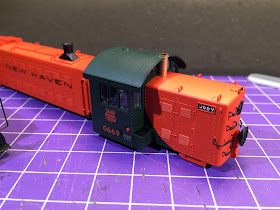Whew - Quite a weekend! It started out Friday night with a small open house for folks coming in from out of town for the
New Haven Railroad Historical & Technical Assn's Annual Reunion/Train Show on Saturday - including
fellow blogger JoeS & his lovely wife, up from PA, MikeR & his missus from MA, DaveM & ReggieD, also from PA, BillC & BillL from NJ, BobA, DickO, & BillS from closer by (CT), and JimW all the way up from FL(?!). Thanks to all of them for taking the time to visit the Valley Line.
NHRHTA's show this year was at the
Valley Railroad and, by all accounts, it was a resounding success. What could be better - a train show, great presentations, and not one but TWO steam-powered trains doing trips throughout the day, with a diesel powered lunch & dinner train as a bonus?! And if that wasn't enough, the entire day was capped off nicely by a "dinner in the diner" aboard the
Essex Clipper.
All in all, a really fun weekend. Here are some photos from the past couple of days . . .
 |
| During the open house - MikeR is showing me how impressed he is with the tower that BillS built. (photo by Mike's missus - Melanie aka Mel) |
 |
| Some of the guys - Mike, Bob, BillL - during the open house (pic by Mel) |
 |
| DickO & DaveM having a convo at Old Saybrook. |
 |
| Overview of the Saybrook station area (pic by Mel) |
One of my visitors -
DaveM - surprised me again by coming bearing gifts . . .
Mentioning that I needed some head-end equipment, he presented me with this great Pennsylvania RR REA refrigerator car.
And speaking of cars, included in his bag of goodies was a car (automobile), a panel truck and - the piece de resistance - a coal dump truck lettered for Valley Coal. How cool is that?! Everything on wheels in the above photo came courtesy DaveM - Thank you again Dave!
After a late night Friday night of running trains and generally great conversation, Saturday morning came early. I got some coffee & donuts for me and Bill & helped set up the display table. Unfortunately, I didn't get
any pictures of the train show itself, Bill's great display for
Rapido, or any of the presentations. Argh! I
did, however, get a couple of new acquisitions:
The MAIN thing is, of course, the lantern. I know it's an Adams & Westlake (heh - "Adams" - so I
had to get it, right?) and it has the embossed NYNH&H on the glass to go with the markings on the top. But other than that, I don't know much about it, how old it is, etc. So if there are any lantern experts out there, please weigh in in the comments (or contact me directly via email)!
Given my evolving interest in interlocking towers due to having a model of Saybrook tower on my layout now, I got the little booklet on the left dealing with all the rules/instructions for dealing with towers. On the right is a little exam booklet for steam locomotive firemen (unfortunately, questions only - no answers(!)) And under them all is what I think is a headrest cloth from a passenger car. It'll make a nice addition to the railroad den (aka "train room") upstairs.
After the show, we had just enough time to get ready to board the dinner train...
 |
| This is not the dinner train, but this was happening in the yard right before we boarded. (pic by Mel) |
 |
| The dinner train itself is a great example of gone-by elegance and a slower, more civilized pace (at about 8mph, actually) (pic by Mel) |
As much fun as the show was, the dinner was even better. I had great table companions (BillS, his missus and daughter) and most of the car was taken up by other show attendees which made for a lot of laughs and a great night.
Whether or not you're a fan of the New Haven RR, I hope you'll consider attending the NHRHTA Reunion & Train Show next year. With any luck/hope, it'll be taking place at the Valley Railroad again which guarantees - no matter what particular railroad you follow - if you're a train buff, you'll have a truly amazing day!

















































